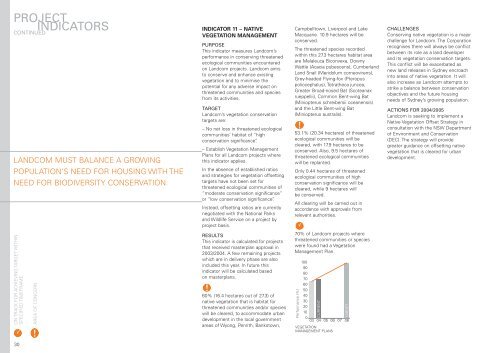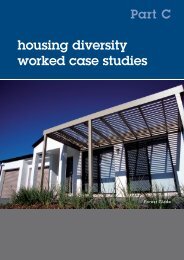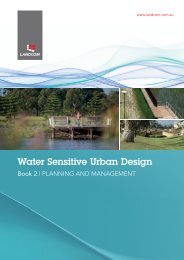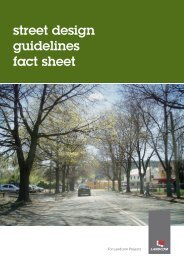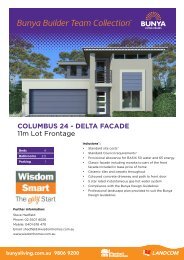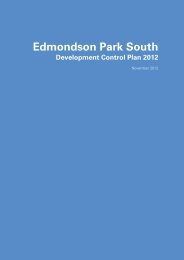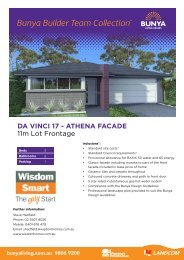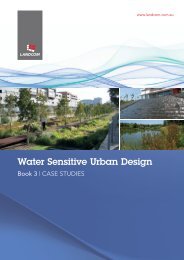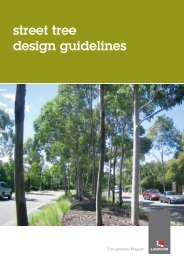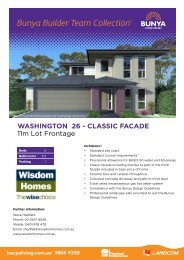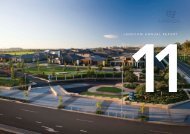SUSTAINABILITY REPORT - Landcom
SUSTAINABILITY REPORT - Landcom
SUSTAINABILITY REPORT - Landcom
Create successful ePaper yourself
Turn your PDF publications into a flip-book with our unique Google optimized e-Paper software.
PROJECT<br />
INDICATORS<br />
CONTINUED<br />
LANDCOM MUST BALANCE A GROWING<br />
POPULATION’S NEED FOR HOUSING WITH THE<br />
NEED FOR BIODIVERSITY CONSERVATION.<br />
INDICATOR 11 – NATIVE<br />
VEGETATION MANAGEMENT<br />
PURPOSE<br />
This indicator measures <strong>Landcom</strong>’s<br />
performance in conserving threatened<br />
ecological communities encountered<br />
on <strong>Landcom</strong> projects. <strong>Landcom</strong> aims<br />
to conserve and enhance existing<br />
vegetation and to minimise the<br />
potential for any adverse impact on<br />
threatened communities and species<br />
from its activities.<br />
TARGET<br />
<strong>Landcom</strong>’s vegetation conservation<br />
targets are:<br />
– No net loss in threatened ecological<br />
communities’ habitat of “high<br />
conservation significance”.<br />
– Establish Vegetation Management<br />
Plans for all <strong>Landcom</strong> projects where<br />
this indicator applies.<br />
In the absence of established ratios<br />
and strategies for vegetation offsetting<br />
targets have not been set for<br />
threatened ecological communities of<br />
“moderate conservation significance”<br />
or “low conservation significance”.<br />
Instead, offsetting ratios are currently<br />
negotiated with the National Parks<br />
and Wildlife Service on a project by<br />
project basis.<br />
Campbelltown, Liverpool and Lake<br />
Macquarie. 10.9 hectares will be<br />
conserved.<br />
The threatened species recorded<br />
within this 27.3 hectares habitat area<br />
are Melaleuca Biconvexa, Downy<br />
Wattle (Acacia pubescens), Cumberland<br />
Land Snail (Meridolum corneovirens),<br />
Grey-headed Flying-fox (Pteropus<br />
poliocephalus), Tetratheca juncea,<br />
Greater Broad-nosed Bat (Scoteanax<br />
rueppellii), Common Bent-wing Bat<br />
(Miniopterus schreibersii oceanensis)<br />
and the Little Bent-wing Bat<br />
(Miniopterus australis).<br />
53.1% (20.34 hectares) of threatened<br />
ecological communities will be<br />
cleared, with 17.9 hectares to be<br />
conserved. Also, 9.5 hectares of<br />
threatened ecological communities<br />
will be replanted.<br />
Only 0.44 hectares of threatened<br />
ecological communities of high<br />
conservation significance will be<br />
cleared, while 9 hectares will<br />
be conserved.<br />
All clearing will be carried out in<br />
accordance with approvals from<br />
relevant authorities.<br />
CHALLENGES<br />
Conserving native vegetation is a major<br />
challenge for <strong>Landcom</strong>. The Corporation<br />
recognises there will always be conflict<br />
between its role as a land developer<br />
and its vegetation conservation targets.<br />
This conflict will be exacerbated as<br />
new land releases in Sydney encroach<br />
into areas of native vegetation. It will<br />
also increase as <strong>Landcom</strong> attempts to<br />
strike a balance between conservation<br />
objectives and the future housing<br />
needs of Sydney’s growing population.<br />
ACTIONS FOR 2004/2005<br />
<strong>Landcom</strong> is seeking to implement a<br />
Native Vegetation Offset Strategy in<br />
consultation with the NSW Department<br />
of Environment and Conservation<br />
(DEC). The strategy will provide<br />
greater guidance on offsetting native<br />
vegetation that is cleared for urban<br />
development.<br />
ON TRACK FOR ACHIEVING TARGET WITHIN<br />
SPECIFIED TIMEFRAME<br />
AREA OF CONCERN<br />
RESULTS<br />
This indicator is calculated for projects<br />
that received masterplan approval in<br />
2003/2004. A few remaining projects<br />
which are in delivery phase are also<br />
included this year. In future this<br />
indicator will be calculated based<br />
on masterplans.<br />
60% (16.4 hectares out of 27.3) of<br />
native vegetation that is habitat for<br />
threatened communities and/or species<br />
will be cleared, to accommodate urban<br />
development in the local government<br />
areas of Wyong, Penrith, Bankstown,<br />
70% of <strong>Landcom</strong> projects where<br />
threatened communities or species<br />
were found had a Vegetation<br />
Management Plan.<br />
Performance (%)<br />
100<br />
90<br />
80<br />
70<br />
60<br />
50<br />
40<br />
30<br />
20<br />
10<br />
0<br />
CURRENT<br />
VEGETATION<br />
MANAGEMENT PLANS<br />
TARGET<br />
03 04 05 06 07 08<br />
30


